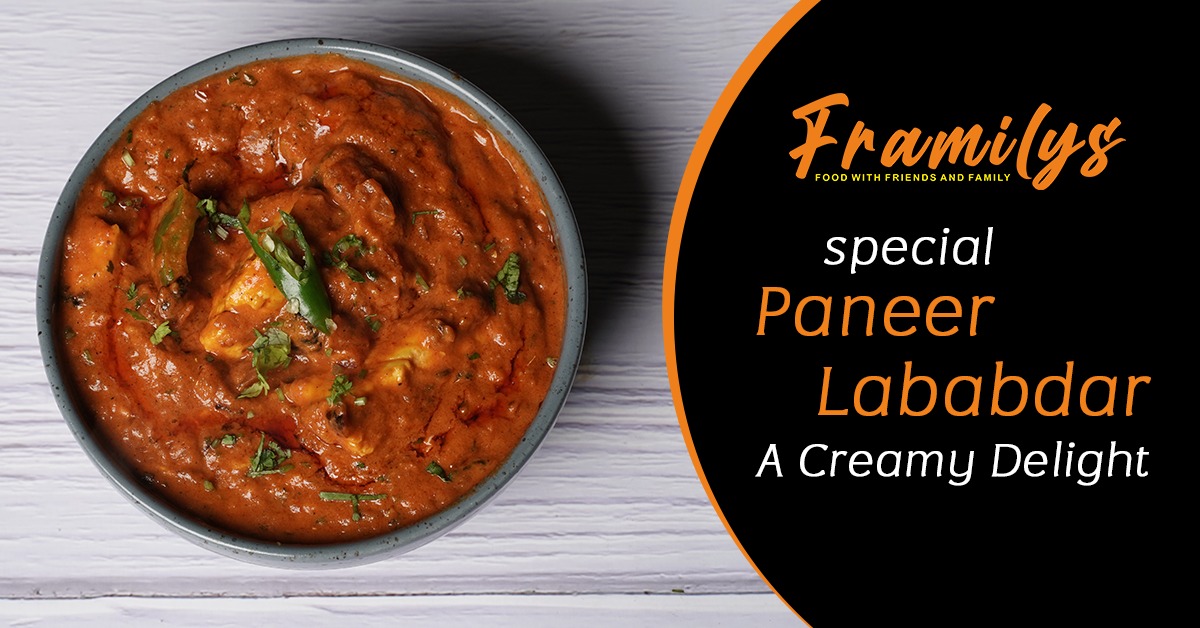Table of contents
Introduction
Paneer Lababdar is a delightful and indulgent dish that originates from North India. This rich and creamy delicacy is made with succulent paneer, luscious cashews, and an array of aromatic spices. Served alongside fragrant rice or warm naan bread, Paneer Lababdar is a favorite among both vegetarians and non-vegetarians alike. In this article, we will delve into the origins of Paneer Lababdar, explore its ingredients and preparation process, and provide tips for enhancing its flavors. So let’s embark on a flavorful journey into the world of Framily’s special Paneer Lababdar.
1. The Origins of Paneer Lababdar
Paneer Lababdar finds its roots in the culinary traditions of North India, particularly in the states of Punjab and Uttar Pradesh. This region is renowned for its rich and creamy dishes, and Paneer Lababdar is no exception. The word “Lababdar” translates to “a dish prepared with great care and attention,” which perfectly encapsulates the essence of this beloved dish. Its creamy texture, robust flavors, and aromatic spices make it a true delight for the taste buds.
2. Exploring the Ingredients
Paneer Lababdar owes its exquisite taste to a combination of carefully selected ingredients. Let’s take a closer look at each one:
Paneer: The star ingredient of Paneer Lababdar, paneer is a fresh Indian cheese made by curdling milk. It has a mild and creamy flavor that absorbs the spices and seasonings beautifully.
Cashews: These creamy and buttery nuts are soaked and ground into a paste, adding richness and a velvety texture to the dish. If cashews are not available, almonds or peanuts can be used as alternatives.
Spices: A medley of spices like turmeric, coriander, cumin, garam masala, and red chili powder lends a depth of flavor to Paneer Lababdar. These aromatic spices create a harmonious balance, making each bite a delight to savor.
3. Step-by-Step Instructions for Making Paneer Lababdar
To create a delectable equally important follow these simple steps Paneer Lababdar recipe,
Step 1: Soaking and Grinding Cashews
Begin by soaking half a cup of cashews in hot water for 30 minutes. Once they are soft, drain the water and grind the cashews into a smooth paste. This will form the base of the dish, providing a luxurious creaminess.
Step 2: Sautéing Onions, Garlic, and Ginger
Heat a tablespoon of oil in a large skillet over medium heat. Add chopped onion and cook until it becomes soft and translucent, which usually takes around 5 minutes. Then, add minced garlic and ginger and sauté for an additional minute, allowing their flavors to infuse the dish.
Step 3: Adding and Cooking the Spices
Now it’s time to bring in the aromatic spices. Add a teaspoon each of turmeric powder, coriander powder, and cumin powder, along with half a teaspoon each of garam masala and red chili powder. Stir the spices into the onion, garlic, and ginger mixture and cook for another minute, allowing the spices to bloom and release their flavor.
Step 4: Incorporating Yogurt and Heavy Cream
Add half a cup of yogurt and half a cup of heavy cream to the skillet, combining them with the spice mixture. Stir well to create a smooth and creamy base. Allow the mixture to come to a gentle simmer, which will ensure that the flavors meld together.
Step 5: Cooking the Paneer Cubes
Next, gently add the paneer cubes to the skillet, ensuring they are well-coated with the creamy sauce. Cook the paneer for approximately 5 minutes, and until it is heated through. Be careful not to overcook the paneer, as it may become chewy.
Step 6: Seasoning and Serving the Dish
Taste the Paneer Lababdar and season it with salt according to your preference. Garnish with freshly chopped cilantro leaves to add a pop of freshness and color. Serve the dish hot and enjoy the creamy, flavorful goodness of Framily’s special Paneer Lababdar.
4. Tips for Enhancing the Flavor and Texture
To elevate the taste and texture of Paneer Lababdar, consider the following tips:
Use full-fat yogurt and heavy cream for a richer and creamier result. This indulgent touch enhances the overall experience of the dish.
If cashews are not readily available, you can substitute them with almonds and peanuts. These nuts will lend their unique flavors to the dish, providing a delightful twist.
Adjust the amount of spices according to your taste preferences. If you prefer a milder flavor, reduce the quantity of garam masala and red chili powder. For those who enjoy a spicier kick, increase these spices accordingly.
5. Serving and Pairing Suggestions
Paneer Lababdar is best enjoyed with complementary accompaniments. Here are two classic pairing options:
Rice: Fragrant basmati rice is the perfect partner for Paneer Lababdar. Its fluffy texture and subtle aroma create a wonderful balance with the creamy paneer and aromatic spices.
Naan: Soft and pillowy naan bread is another fantastic choice to accompany Paneer Lababdar recipe. Tear off a piece of naan, scoop up the creamy curry, and savor the burst of flavors in every bite.
Conclusion
In conclusion, Finally Framily’s special Paneer Lababdar recipe is a tantalizing dish that brings together the rich and creamy goodness of paneer, the nuttiness of cashews, and a symphony of aromatic spices. With its roots in North Indian cuisine, Paneer Lababdar offers a delightful dining experience that satisfies both the palate and the soul. Whether enjoyed with fragrant rice or warm naan bread, this dish is sure to impress and leave a lasting impression.
FAQs
Answer: yes, Paneer Lababdar is a vegetarian dish as it is made primarily with paneer, which is a type of Indian cheese.
Answer: Yes, you can use store-bought paneer for Paneer Lababdar. However, homemade paneer often has a fresher and softer texture.
Answer: Yes, you can prepare Paneer Lababdar in advance. Simply reheat it gently before serving to retain the flavors and textures.
Answer: The level of spiciness in Paneer Lababdar can be adjusted according to personal preference. You can increase or decrease the amount of red chili powder and garam masala to suit your taste.
Answer: While it is possible to freeze Paneer Lababdar, the texture of the paneer may change slightly upon thawing. It is best enjoyed fresh for optimal taste and texture.




